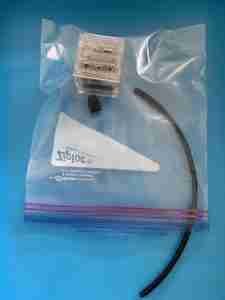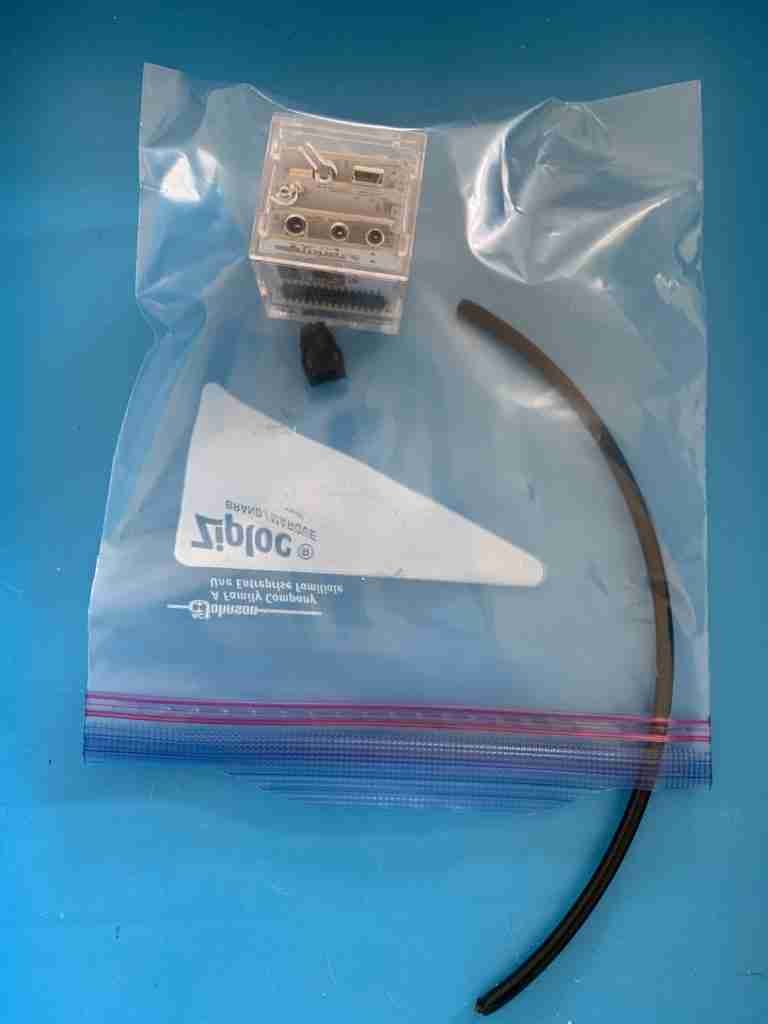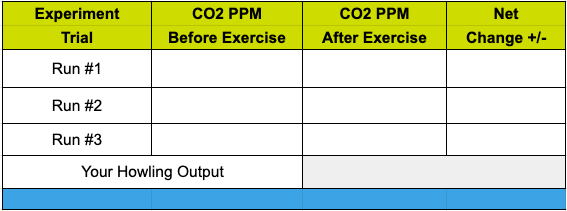Breathe
PDQ1 |
Huff, puff, hop, and howl!
Overview
Grades:
Time:
Subject:
5-8
5-15 minutes
Life Science
Your respiratory system extracts oxygen and expels CO2. Do you think your respiration changes when you exercise?
Background
Our respiratory system is one of many systems in our body and it is made up of the trachea (windpipe), bronchial tubes, lungs, a diaphragm and more. Remarkably, we don’t think about it even though it is operating constantly and we take a breath about 20,000 times per day. Its basic function is to take in oxygen (O2), which we need to convert our food into energy, and it expels carbon dioxide (CO2), the waste product of our energy conversion process.
Running, hopping, and jumping about makes us breathe harder – why? Our body’s respiratory system provides the oxygen we need to produce energy, and when we are running about, we need more of it. Since CO2 is the waste product of respiration, do you think we exhale more or less of it when we are exercising?
Let’s explore further with databot™ and find out!

What You'll Need
- IOS or Android smart device with Bluetooth Low Energy (BLE) to connect to databot™
- databot™ + Phypox App installed on your IOS or Android device
- Plastic bag – 1 quart size, ziplock preferred!
- 9″ of 5mm pneumatic tubing
Objectives
By completing this experiment and conducting the scientific observations associated with it you will master the following knowledge! Good luck science explorer!
- The human respiratory system is one system of many in the human body and it is responsible for breathing!
- Carbon Dioxide (CO2) is:
- An invisible and odorless gas.
- Exhaled by human beings in the process of respiration.
- Oxygen (O2) is:
- An invisible and odorless gas.
- One of the primary elements in the air we breathe (21%).
- Extracted from air in the alveoli, tiny sacs in your lungs.
- Used by the cells in your body to convert sugars to give you energy!
- Exercise, holding your breath, and other actions affect respiration.
- Scientific sensors allow us to measure the scientific world around us with better precision and accuracy.
Important Terms
Air Pressure: The weight of the air above us pressing down. We don’t feel it normally because it is always there, but air has weight!
Alveoli: Tiny air sacs in your lungs that facilitate the exchange of oxygen into your bloodstream and carbon dioxide out of it.
Bronchial Tubes: Branch off your trachea and carry the air you inhale into your lungs.
Bronchiole: Smaller passages off your bronchial tubes that lead to the tiny air sacs known as alveoli where gas exchange takes place.
Carbon Dioxide (CO2): A colorless, odorless gas naturally present in the air you breathe and is absorbed by plants in photosynthesis. There would be no animal life or green plants without carbon dioxide. Green plants use energy from the sun plus carbon dioxide and water to produce carbohydrates and oxygen.
Diaphragm: A dome shaped muscle-membrane that separates your thorax from your abdomen. It plays a major role in breathing by contracting and changing the volume in your chest cavity which allows fresh air to rush in and deliver oxygen!
Exhale: To breathe out.
Homeostasis: Your body’s systems and processes that help maintain a balance of things like your oxygen and CO2 levels.
Inhale: To breathe in.
Lungs: Spongy organs located in your chest cavity that take in oxygen and expel carbon dioxide.
Oxygen (O2): A molecule formed of two oxygen atoms and is a major component (21%) of the air we breathe. When we breathe, we extract oxygen from the air and absorb it into our bloodstream. Our cells then use oxygen to convert food to energy!
Respiration: Facilitates the production of energy in the body through the process of breathing in oxygen and expelling carbon dioxide.
Respiratory System: Your lungs, airway, and associated muscles, are responsible for breathing – taking in oxygen and expelling carbon dioxide.
Trachea, or windpipe: A large tube that conveys air to and from your lungs. It is an important part of your respiratory system.
Prep (5 Mins)

This is a fun and simple activity that will involve you measuring your CO2 output using databot™ in a small plastic bag.
- Setup your bag and databot™ as shown here.
- Make sure your databot™ is fully charged.
- Prepare to hop around a bit so you can test your CO2 level before and after exercise!
PDQ 1 (10 mins)
Look for these important terms that identify important parts of your respiratory system on the diagram to the right. Trace their location on your own body. You are about to give them a workout!
- Trachea
- Bronchial tube (Bronchus)
- Lungs (Right and Left)
- Diaphragm

Procedure
- Place your charged databot™ in your bag as shown.
- Select the Human Respiration experiment on your Phyphox app and connect to databot™. Start the data display.
- Exhale gently into the bag through the straw, the bag will inflate and air will leak out around the straw which is fine.
- Write down the highest level displayed by databot™ in the “Before” space.
- Now exercise for two full minutes doing jumping jacks, running in place, hopping, etc. to get your heart rate up. Work as hard as you can and think about your breathing. Stop after two minutes.
- Reset your Phyphox experiment and begin a new session. Now breathe again into the bag with databot™. Write down the new value and calculate any change.

- Is your CO2 level higher, lower, or the same?
- If you have time, repeat the experiment twice more and record the values. Are the results similar each time?
- Do you think your CO2 output changes when you sing or howl? Try howling into the bag and compare your results to the exercising and original “at rest” values.

Educator Info
Educator Info
- Study the background information in the Overview and familiarize yourself with the learning objectives and terms for this activity.
- Test the CO2 reading in your app and conduct the PDQ yourself before conducting it for your class.
- Review the guiding questions to help guide the student experience.
- If students have potential respiratory problems such as asthma be cognizant they may not be comfortable doing this activity.
Understand:
- The human respiratory system is one system of many in the human body and it is responsible for breathing!
- Carbon Dioxide (CO2) is:
- An invisible and odorless gas.
- Exhaled by human beings in the process of respiration.
- Oxygen (O2) is:
- An invisible and odorless gas.
- One of the primary elements in the air we breathe (21%).
- Extracted from air in the alveoli, tiny sacs in your lungs.
- Used by the cells in your body to convert sugars to give you energy!
- Exercise, holding your breath, and other actions affect respiration.
- Scientific sensors allow us to measure the scientific world around us with better precision and accuracy.
MS-LS1-3. Use argument supported by evidence for how the body is a system of interacting subsystems composed of groups of cells. (Grades 6 – 8)
Disciplinary Core Ideas
In multicellular organisms, the body is a system of multiple interacting subsystems. These subsystems are groups of cells that work together to form tissues and organs that are specialized for particular body functions.
Cross Cutting Concepts
Systems may interact with other systems; they may have sub-systems and be a part of larger complex systems.
- When you exercise does your breathing speed up or slow down?
- What do you think will happen when you exercise, will your CO2 level increase or decrease?
- Why?
Khan Academy Video: Meet the lungs
Khan Academy Video: Oxygen movement from alveoli to capillaries
Khan Academy Video: Inhaling and Exhaling
Breathe Cover Photo by Fabian Møller on Unsplash
Respiratory diagram Creative Commons 3.0 licensed work from Wikimedia.
 Breathe by Robert O. Grover & Team databot™ is licensed under a Creative Commons Attribution 4.0 International License. Permissions beyond the scope of this license may be available at databot.us.com/contact.
Breathe by Robert O. Grover & Team databot™ is licensed under a Creative Commons Attribution 4.0 International License. Permissions beyond the scope of this license may be available at databot.us.com/contact.
